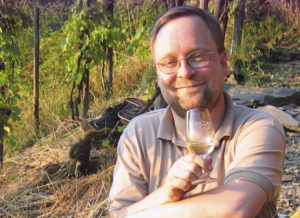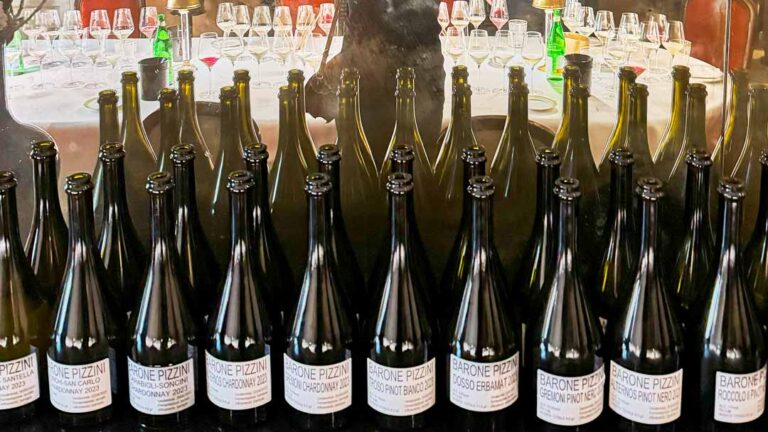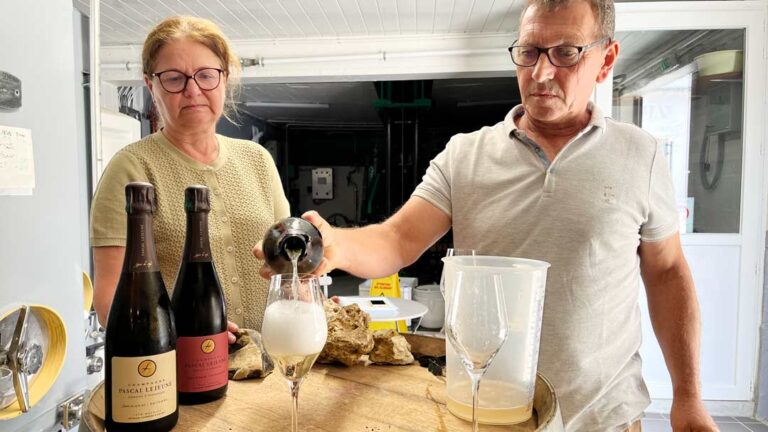Pierre Peters is one of the leading small growers in Champagne and can be found in Le Mesnil-sur-Oger, one of the grand cru villages of the Côte des Blancs. In this village the grape variety Chardonnay rules almost alone, and Le Mesnil-sur-Oger is one of the best villages of blanc de blancs Champagnes. Pierre Péters is headed today by Rodolphe Peters. When he visited Sweden earlier this year he met with BKWine’s reporter Tomas Eriksson together with the Swedish importer The WineAgency. Pierre Peters has become a real bestseller in Sweden, but a bestseller that has always kept the quality up. Champagnes from here are really classic Blanc de Blancs!
Rodolphe had not only brought new releases and vintages but also two new champagnes that broaden the range of champagnes at the top: one late degorged version of the prestige champagne Les Chétillons and also the new L’Étonnant Monsieur Victor.
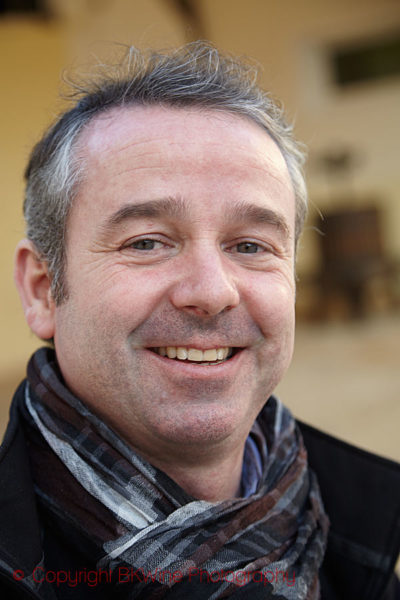
In the centre of the tasting was Pierre Péters prestige champagne Les Chétillons, which is also the name of a vineyard located in Le Mesnil-sur-Oger. In this vineyard Pierre Péters has three plots of vines of 40-70 years that are vinified separately in oak barrels. Each year Les Chétillons is the best possible blend of the base wine from these three plots. In the past this was called Champagne Cuvée Spéciale, but since a number of years the vineyard name is highlighted.
The vintage now being launched is 2008, a classic and very high-quality vintage in which Les Chétillons performs just as well as one can expect. It may be worth noting that the 2009, a vintage with a little warmer character, was released before the 2008.

A novelty is that Pierre Peters started setting aside a small amount of bottles of Les Chétillons to sell them later with the additional designation Œnothèque. These bottles are different by being degorged later than the regular release, and being sealed with a natural cork while in the cellar, which gives a different maturation process. (Normally the champagne bottles are sealed with crown cap.) Rodolphe believes that natural cork makes for better integration of the mousse, which becomes softer, and the champagne gets more character of hazelnuts, almonds and dried fruit. The 2000 vintage is the first release of the Œnothèque version of Les Chétillons.
Pierre Péters Cuvée de Reserve
Tasted from jeroboam (3 litres), base vintage 2010. This format is part of the importer’s restaurant range.
Scent of green and yellow apple, a little mineral smoke and toasty notes. Dry, clean and elegant taste of green apple, citrus, chalky and stony mineral tone, high acidity and green apples in the aftertaste. 89+ p
A classic Blanc de Blancs with greater depth and some more development than typical for non-vintage 75 cl bottle, but it would undoubtedly improve with more ageing.
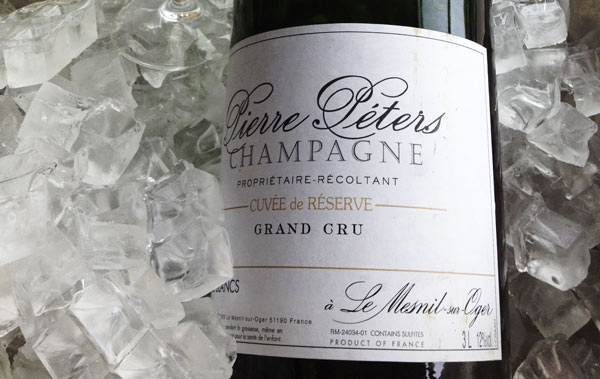
Pierre Péters Extra brut
Base vintage 2011, ~38 euro (all prices are estimates based on Swedish retail prices).
Aroma of green apple, mineral, herbal tone with hints of green. The taste is dry, tight, very mineral-dominated by green apple, high acidity and mineral-dominated finish. 87-88 p
Very tight, a little slimmer than other Champagnes in the tasting, which is probably due to the base year. Some bottlings (vintages) of this champagne is sold as vintage champagne, primarily those that are more generous in style. 2011 had instead become an Extra Brut without vintage.
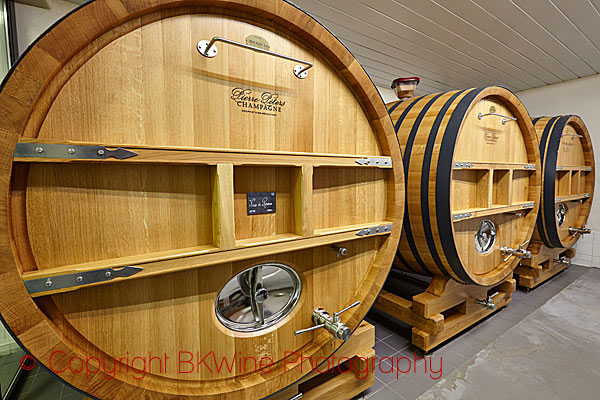
Pierre Péters Cuvée L’Esprit 2010
~45 euro
Aroma of citrus, ripe green apple, mineral and toast. The taste is dry with green apple, very distinct mineral tone, high acidity and fresh aftertaste. Very clean and healthy. Fairly ready to drink now but can develop more. 90p
L’Esprit is Pierre Péters “standard” vintage champagne, and is sold younger than the prestige champagne Les Chétillons. Compared with the Cuvée de Réserve on the big bottle there are more mineral taste and more fruit tones. It’s actually a little bit more ready to drink. I think that 2010 is proving to be a good vintage for blanc de blancs Champagnes, because it is a vintage with high acidity level and pure tones.
Pierre Péters Cuvée L’Esprit 2009
~45 euro
Aroma of ripe green and yellow apple, some winter apples, minerals and toast. The taste is dry with citrus, green apple, good acidity (but not extremely high) and minerals. Aftertaste is appley and fruity with minerals. 89p
The 2009 vintage shows a little more warmth and ripe-grape character compared with the vintages 2008 and 2010. This means that this is little more developed than the previous wine, and the acidity and minerality are not quite as high, which gives a little more appley-fruity impression.
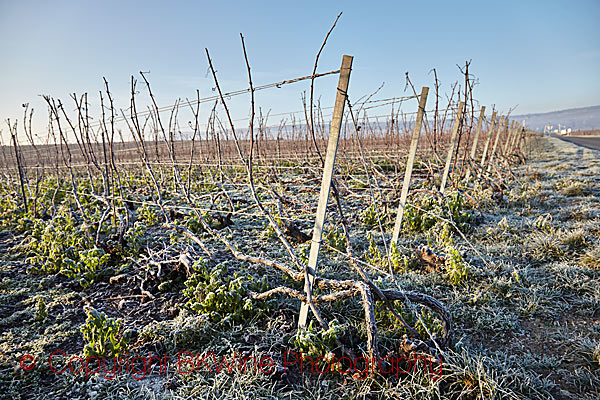
Pierre Péters Rosé for Albane
Base year 2012, 55% chardonnay from Le Mesnil-sur-Oger and 45% pinot meunier from Cumieres vinified with the saignée method, ~40 euro.
Aromas of green and red apple, some red berries, hint of liquorice, a bit of herbal and green tones. The taste is dry with citrus, green apple and some red apple, mineral and relatively high acidity. 87 p
Rosé for Albane is the only champagne in the range that is not a pure Chardonnay. The composition with a high proportion of Pinot Meunier is a bit unusual for a rosé from a blanc de blancs producer. The meunier comes from René Geoffroy in Cumieres. This champagne has sometimes made me scratch my head a bit and I think it has a different personality than the rest of the range, although chardonnay predominates in the taste. Albane is, by the way, Rodolphe Péters’ daughter.
Pierre Péters Reserve Oubliée
Base year 2008 and a continuous mix of vintages back to 1988, ~55 euro.
Aromas of ripe yellow apple, other yellow fruit, some dried fruit, some mineral tones and some bread. The taste is dry with a distinct mineral tone, ripe yellow fruit, good acidity, fruity yet balanced taste. It has some quite mature characters, but is still surprisingly young and fruity considering what is hidden in the bottle. 91-92 p
Previous bottlings of Réserve Oubliée have also been good, but this version definitely outshines the ones I tried before. It seems that the excellent base year of 2008 have interacted with the older wines to a brilliant whole, so this was a very pleasant acquaintance. This bottle has been under crown cap in the cellar, but starting from the bottling that is based on the 2011 vintage it will instead be aged with natural cork during the second fermentation until disgorging, to further accentuate the notes of maturity.
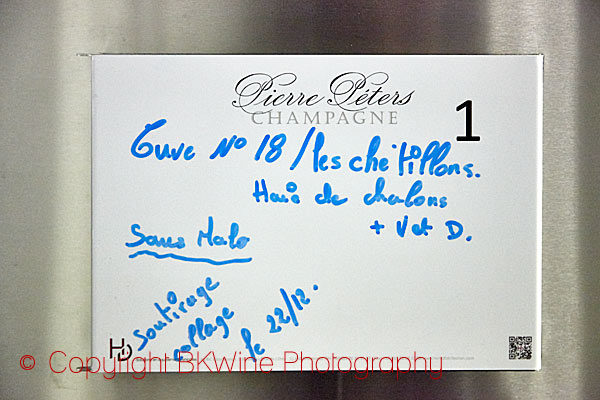
Pierre Péters Les Chétillons 2008
~75 euro
Scent of ripe citrus, distinct mineral tone, white flowers, well-integrated and fine oak character. Relatively strong but elegant and young nose. Dry and austere taste, citrus, green apple and some yellow apple, good acidity, very mineral, high acidity, aftertaste of apple and minerals. Young. 95+ p
Les Chétillons lives up to the high expectations that one can have on a prestige champagne in the top vintage 2008! As with most newly launched Les Chétillons the 2008 should definitely be given more age, but I think it will be approachable earlier than the 2007. The vintage shows, as expected, significantly more substance than the 2007.
Rodolphe Peters comments:
“The description seems to suggest that this cuvée is vinified in barrel giving it certain toasty even oaky characters. But les Chétillons has clearly always been 100% vinified in stainless steel tanks.”
“Those ‘barrel flavours’ are related to a well managed autolysis in tank as well as a specific imprint of Le Mesnil that always leads my family not to work in oak to let space for this wonderful terroir to express itself.”
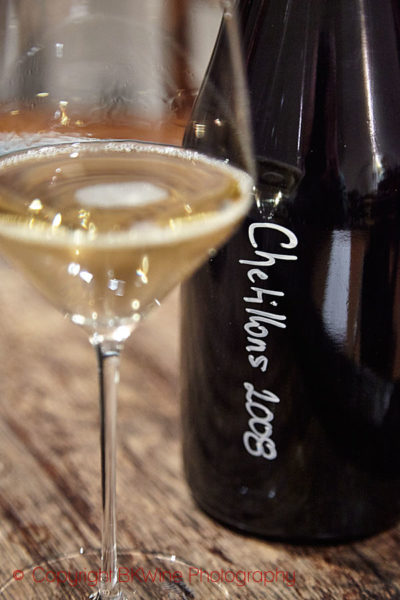
Pierre Péters Les Chétillons 2007
~66 euro
Nose with very mineral character, some citrus, green apple, discreet toasty tone and subtle oak character. Elegant and austere aroma, but still a youngish feeling. Dry and austere flavour with plenty of minerals, some citrus, some green apple in the background, high acidity, good concentration but no heavyweight. Young, can develop more, 93+ p
Austere style, typical of the vintage. 2007 is a bit sleeker vintage with high acidity, which fits well for many blanc de blancs.
Pierre Péters Les Chétillons 1997
Strong and developed nose with ripe yellow fruit, yellow apples and yellow plums, distinctly smoky and toasty. The taste is dry and tight with lots of minerals, high acidity and great freshness. Amazing developments in the aroma, the taste gives a much younger and tighter feeling. Therefore, I believe it can develop more. 94 (+) p
The producer characterized 1997 as a good but not so famous vintage, and seemed to have been a little surprised at how good it was.
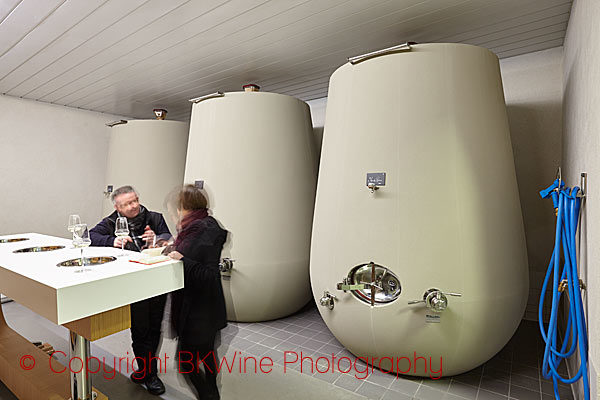
Pierre Péters Les Chétillons 1995
Aromas of ripe yellow apple, yellow fruit, bread, seawater with seaweed, mineral, some smoke and butter. Full-bodied taste that is dry and relatively tight, ripe yellow apple and green apple, good acidity and minerals. Good maturity now, but can withstand more age if you like developed champagnes. 93-94 p
Pierre Péters Œnothèque Les Chétillons 2000
Degorged in December 2013, 130 euro.
Aromas of ripe yellow apple, spices, toast, a little cocoa, minerals, distinctly developed notes with some muskiness, a hint of mushroom, well-integrated barrel notes. Taste has good concentration, yellow apples, slightly ripe apples, some dried fruit, good acidity, mineral, spices. Really nice maturity. 93-94 p
A lot of mature characters and “dark” tones but still some youthful minerality. 2000 is a vintage in champagne with a strong body that has matured relatively fast, which here works in parallel with the natural cork style.
Pierre Péters L’Étonnant Monsieur Victor Edition MK.09
50% Les Chétillons 2009 and 50% older reserve wines back to 1988, as well as an artistic label designed by Rodolphe’s son Victor (in a style reminicent of Mourakami), ~155 euro
Nose with ripe yellow fruit including yellow apple, yellow plums, hint of tropical fruit, some dried fruit, minerals and toast. Dry taste, slightly yellow fruit, yellow apple, yellow plum, good acidity, distinct mineral tone, finish with minerals. Fully ready to drink. 92-93 p
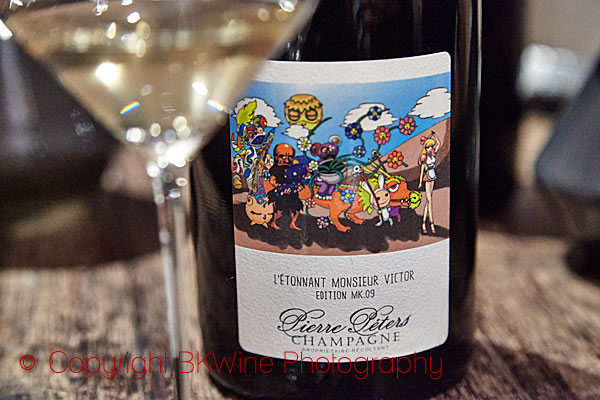
This newly launched champagne has both a kinship with Les Chétillons and Réserve Oubliée in terms of the grape material, and it shows. It is clearly more mature than a young Les Chétillons but also much more mineral than Réserve Oubliée. It is noticeable, however, in the style that the base year (2009) is a vintage with character of very ripe grapes. Victor is Rodolphe Péters’ son.
Tomas Eriksson is one of the contributors on BKWine Magazine. He is active in the wine tasting association AuZone in Stockholm and in Munskänkarna, where he sometimes holds wine courses. Tomas also runs a blog called Vintomas.
[box type=”info” style=”rounded” border=”full”]Growers’ champagnes are exciting to discover, with their individuality and expression. They are of course prominently featured on BKWine’s wine tour to Champagne, in addition to the traditional houses.
Keep an eye out for the new book about Champagne and growers that will be coming early next year.
Travel to the world of wine with the experts on wine and the specialist on wine tours.
Wine tours which open new doors. BKWine Wine Tours.
[/box]


